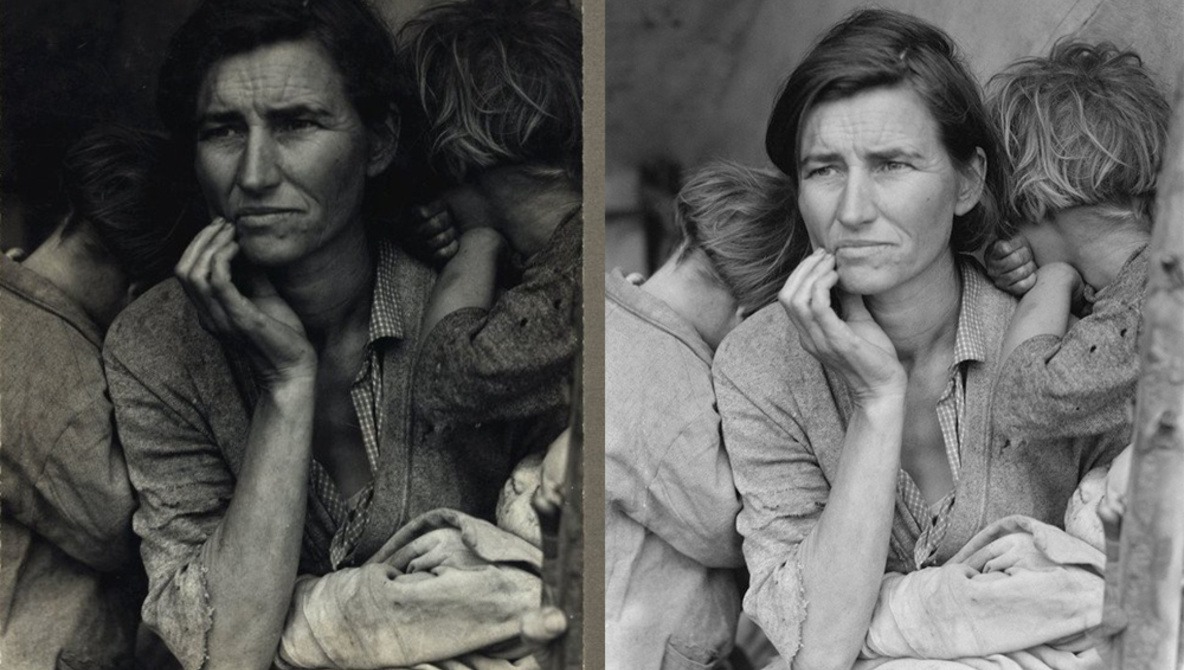One of the most iconic photos that came out of The Great Depression was “Migrant Mother” by photographer Dorothea Lange, and it was "Photoshopped" to remove a “defect.”
In her new book “Dorothea Lange: Migrant Mother,” Museum of Modern Art curator Sarah Meister shares a tip on how to tell if a reprint of the iconic photo was made before or after 1939 by inspecting the mother’s left thumb. Lange “considered the thumb to be such a glaring defect that she didn’t have a second thought about removing it” when she instructed her assistant to retouch the photo and remove Florence Owens Thompson’s thumb.

![]()
Though her decision may have gotten her under fire, as she was on assignment by the US Government’s Resettlement Administration and the Farm Security Administration (FSA) to spotlight the lives of impoverished Americans. Her FSA boss, Roy Styker, was not happy with the decision to manipulate the photo, as he believed it compromised the authenticity of the photo and his documentary project.
The original, unretouched version of the image can be found in the Library of Congress.
Read more on the background story of the "Migrant Mother" on a previous post of ours by writer Christopher Malcolm.







Where is the information that Roy Stryker took issue with this particular retouching? Minor retouching such as that was common in documentary photography and journalism throughout the darkroom era.
It's only been in the actual "Photoshop" era that the ethic has turned to one of absolutely no retouching.
Making a big deal about removing a thumb in this picture is just virtue signalling.
thumbs up
So what?
Honestly Took me a minute to even find the thumb. I don't feel like it's changed enough to manipulate the context of the negative. It's a close up portrait so there's going to be bias due to the fact that the photographer is directly interacting with the subject while taking the photo. It's not candid enough to get wishy washy over the removal of a thumb. Just my 2 cents...
Kind of odd to use the word photoshopped in the headline and brief story. The documentary photo should not have been retouched. Cropped, but not retouched. Stryker was right.
Read up, then, on W. Eugene Smith, described as "perhaps the single most important American photographer in the development of the editorial photo essay" who was also renown for spending days in the darkroom retouching his famous documentaries.
http://smithfund.org/smith-legacy
Heck, in my day, Smith's extreme level of documentary/photojournalism retouching was taught in schools.
So I have a very hard time believing that Stryker so much as blinked at the removal of a peripheral thumb.
It was actually retouched, not Photoshopped, unless Adobe has been around way longer than I ever knew.
It does remind me of the famous Beatles photo where Paul's cigarette was retouched out.
http://www.wksu.org/news/images/37789/Beatles-IWantToHoldYourHandAirbrus...
I agree it looks better without the thumb, but it took me FOREVER to actually find the thumb in the first place. So I don't really think it makes that much of a difference had I not been 'told' to look for it.
It in no way changed the meaning of the photo. Much ado about nothing in my opinion.
I see it now. I agree with the decision to retouch it out. It was an insignificant but potentially distracting element to the overall image as your attention was required on her face and not being photobombed by her thumb.
Editing an image is not a bad thing. Painters and sculpters have been doing it for centuries.
I agree with others about "retouching" - having studied photography in the late 1960s- early 1970s, I can affirm that we were taught to dodge, burn in, bleach, and even use retouching fluids with 00 brushes to retouch both the negative and the final print.
In fact, the government officials did not want any retouching, but they also expected the sort of bland photographs that would have come with typical field work, so a ruler to show the height of corn and so on. Instead they got art.
In fact, the title is misleading. In its era, it would have been considered a typical print.
This should quiet the straight out of camera purists who are always bragging about SOC be real and every post process is a flaw of the photographer skills.
I had no idea there were such snobs out there. Having recently attended an Ansel Adams exhibit, it's laughable that anyone thinks post-processing is optional or a crutch for skill. As Adams put it (paraphrasing): "The negative is the sheet music. The print is the performance!"
I think the fact she made up the story about the family is a lot worse than her removing a thumb from the photo. The story told by the subject of the story and the story reported by Lange is quite different. I stated suspecting it when I read about the children eating frozen peas in a field after a frost. In Nipomo?
As I understand it, the story actually came from a government writer who came along a day or two after the photos were taken, and there is some question as to whether he actually connected his interviews with the correct photo subjects.